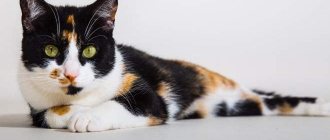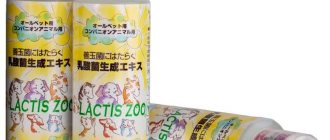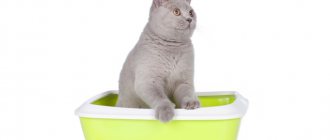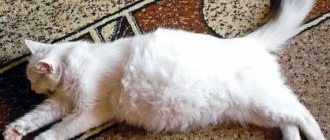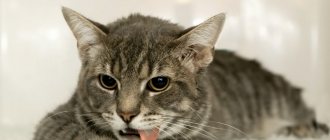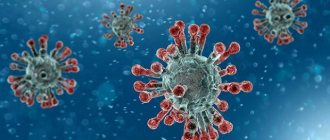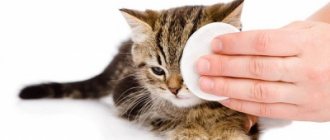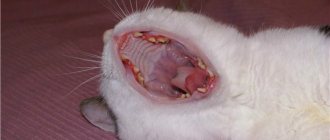Intestinal obstruction (ileus) is a pathology in which the passage of feed masses becomes difficult or stops. It can be dynamic or mechanical, partial or complete. Regardless of the type, this condition is life-threatening for the cat and often causes death. If symptoms of ileus occur, you should urgently show the animal to a veterinarian. Once the cause is established, conservative or emergency surgical treatment is performed.
Causes of the disease
Intestinal obstruction can be caused by numerous factors. The reasons causing stagnant processes include the following:
- Ingestion of foreign objects and hair into the intestines, which the cat may accidentally swallow. This reason is the most common - up to 80% of all cases.
- Infection with helminths. Live and dead worms in excessive quantities form into clumps that completely block the intestinal lumen.
- Coprostasis observed over a long period of time. Dry feces form a dense plug that closes the intestines. Constipation is most often a consequence of poor diet. Undigested food and decay products, among other things, also poison the animal’s body.
- Volvulus. A constriction that occurs in a certain area of the intestine disrupts blood circulation, as a result of which the organ dies and decomposes.
- Intussusception. It is a consequence of intestinal volvulus and is characterized by the penetration of one intestine into another.
- Malignant and benign neoplasms in the intestine. First, tumors provoke a partial blockage, then, as they grow, they cause a complete blockage.
- Intestinal paralysis. The cause of organ paralysis may be injury to the spine, intestines, diseases of the nervous system, etc.
Regardless of the factor that caused ileus, measures to eliminate intestinal obstruction should be taken immediately.
Prevention
Prevention of intestinal obstruction in cats is extremely important. Let's look at the 3 main components of effective prevention.
Review your pet's diet
If you feed dry food, do not forget that the animal should always have access to clean and fresh water. And pay attention to those that have a “function” - to help remove hair from the digestive tract. This food is especially good for long-haired cats or old cats (or those that shed heavily).
Brush your mustache
Don't neglect this. Buy special combs, combs, mittens. The more carefully you care for your pet, the better its fur will look and the cat will feel. Agree, if you comb a cat’s skin, then when licking the purr, it will swallow a minimum of hairs.
No small or inedible items
Do not let your purring pet play with small and inedible objects (plastic bags, tinsel or New Year's rain, threads, pieces of paper, candy wrappers, etc.). During play, the animal may swallow them, they will not be digested, and the lumen of the digestive tract will be “closed.” Keep your pet away from your laces, buttons, and locks. Also remove toys with small parts; after all, the cat can chew them while playing and choke on the small parts. Hide the trash can too! Skins, bones, sausage casings - all this can be easily pulled out of the trash. The cat will eat this poison and clog its gastrointestinal tract.
Still have questions? You can ask them to our site's in-house veterinarian in the comment box below, who will respond to them as soon as possible.
Which breeds are more susceptible
Ileus can occur in any cat, regardless of age or gender. Representatives of long-haired breeds, for example, Persians, Siberians, Maine Coons, are most susceptible to this phenomenon. Numerous hair that enters the stomach during licking forms trichobezoars - dense hairballs. They are the most common cause of intestinal obstruction.
Kinds
As surprising as it may sound, there are several types of intestinal obstruction in cats.
- Mechanical
. With this type, the intestines are blocked or pinched by something. For example, intestinal volvulus, a foreign object or hair clogged the gastrointestinal tract, - Functional
. He's paralytic. It is registered as a result of peritonitis, atony of the intestinal walls (when they are weak, there is no tone and peristalsis), disturbances in nervous activity, or during the period when the animal “recovers” from anesthesia. This is why you should not feed the animal after surgery. Even if the cat asks, you cannot feed it in the first hours after “recovering” from anesthesia.
Main symptoms
At the initial stage, obstruction (ileus) practically does not appear. Signs such as nausea, constipation, and bloating should alert the owner.
As the disease progresses, the cat stops showing interest in food and does not drink. This is due to the fact that the stomach does not empty and becomes larger due to undigested food. Nausea progresses to vomiting, attacks of which occur every 15-20 minutes. Vomit sometimes contains stool particles.
There is no chair. At the onset of the disease or in case of partial obstruction, small passages of feces formed before the intestinal blockage are possible.
Due to the fact that gases do not escape, the cat's stomach becomes bloated. The pet constantly licks it, feeling severe pain. Fluffy doesn't allow you to touch his belly.
During palpation, you can feel the tension and hardness of the abdominal cavity; sometimes a foreign body that the cat has swallowed can be felt.
Caring for a sick cat
After initial treatment, symptoms and progress should be monitored. It is important to replace fluid loss (for example, due to excessive vomiting or diarrhea) to avoid dehydration.
Physical activity should be limited and the diet should consist of bland foods for one to two days, followed by a gradual return to normal eating. Please note that it should not be given orally until the obstruction has been removed and vomiting has stopped.
Diagnostics in a veterinary clinic
To make a diagnosis, the veterinarian examines the animal, studies the medical history, and also prescribes the necessary diagnostic measures. To determine the severity of intoxication, the cat's urine and blood are examined.
X-rays with a contrast agent and ultrasound are not advisable, since the studies do not give an accurate result.
The only complete and informative diagnostic method for blockage of the intestinal lumen is laparotomy.
Treatment method and prognosis
There is no single treatment regimen for ileus. In addition, it is necessary to determine in which part of the intestine stagnation has formed. Only laparotomy can show this.
Important: stagnation in the small intestine is most dangerous. Under pressure from the contents, the intestinal wall can rupture, leading to immediate death.
Treatment for intestinal obstruction includes two stages:
- laparotomy, which is regarded as a full-fledged operation;
- rehabilitation period.
The postoperative period is given great importance. To make the recovery process as easy and quick as possible, the cat should not be fed for 48 hours; water should only be given every other day.
To stabilize the condition, it is indicated to restore the water-salt balance and relieve intoxication through intravenous infusions of saline solutions. A course of antibiotic therapy is required.
Nutritional adjustments and the use of medicinal feed are necessary.
Medicinal and cleansing enemas using medicinal plants will help remove the irritating effect from the intestinal walls. It is acceptable to use linseed oil and vaseline oil. With the help of painkillers and anti-inflammatory medications, pain is eliminated and the inflammatory process is relieved.
To strengthen the immune system, restore microflora and support general condition, it is advisable to use probiotics and immunostimulants.
What to do at home
The owner is required to follow the instructions of the specialist. It is strictly forbidden to prescribe medications to your cat yourself, or to reduce or increase the dosage. Self-medication is dangerous and can cause irreparable harm to your pet! Traditional methods (herbs, massages, etc.) can help with bloating, constipation, but not with ileus. It is impossible to get rid of this phenomenon at home.
If you suspect intestinal obstruction, you should immediately take your pet to a hospital or call a veterinarian at home. You cannot feed your pet or give it water before examining a specialist! Food and water will only aggravate the situation and cause profuse vomiting, which can lead to dehydration.
You should not give laxatives, much less try to relieve your cat’s intestines with an enema. Cleansing procedures are prescribed by a veterinarian, taking into account the condition of the animal and confirmation that the enema will not lead to intestinal rupture.
Symptoms
Symptoms of gastrointestinal obstruction often vary depending on the behavior and character of the animal:
- Apathy and drowsiness, in which the cat tries to hide in a quiet, dark place; or, conversely, active meowing and running after the owner in order to attract his attention. What both cases have in common is a serious change in the cat’s behavior, which a loving owner will notice immediately.
- There is no appetite up to complete refusal of food. Sometimes a cat can swallow the food offered, but immediately after this the obstruction causes vomiting of everything consumed.
- Vomiting 30-40 minutes after feeding appears if the obstruction is partial, when, due to the small lumen, all the food cannot move forward and a vomiting spasm occurs.
- Acute abdominal pain, due to which, when the owner tries to examine the pet, the cat reacts aggressively, actively biting and scratching. If it is possible to palpate, a sharp tension in the muscles of the peritoneum is noted, and the location of the blockage is often determined along with the foreign body that caused the obstruction.
- Bloating. Occurs due to retention of gases in the intestines or their complete failure to pass. To relieve discomfort, the cat tries to stimulate bowel movements by actively licking the stomach or rolling on the floor.
- Lack of bowel movements is a clinical sign of obstruction. However, the owner should remember that if the tray is clean, this may not always indicate an obstruction of the gastrointestinal tract, and there is a possibility that the cat simply chose a different place for its business, which, naturally, is not at all suitable for replacing the tray.
It is important that the owner treats his pet carefully and, if there is the slightest suspicion of intestinal obstruction, take the cat to the veterinarian.
Possible complications
You need to understand that ileus is a very dangerous condition. If left untreated, intestinal obstruction leads to disastrous consequences, including death. Feces, gases, and gastric juices accumulate in the intestines, as a result of which the blood supply is disrupted and necrosis (death of the intestinal walls) develops.
In addition, the body receives severe poisoning from decay products. This leads to the death of intestinal microflora and the development of putrefactive processes in the intestines.
The situation with partial ileus is somewhat simpler, when the intestinal lumen does not close completely, allowing gases and a small amount of feces to escape. However, this does not mean that treatment is not required.
The essence of the problem
In the stomach of any animal there is a continuous production of large amounts of digestive juices. This process is absolutely independent of food intake and occurs even during prolonged fasting. The main function of the intestines is to push the contents of the stomach towards the anus. As they move through the organ, these digestive juices are absorbed back through the intestinal walls, but along with nutrients, carrying out a constant circulation of large amounts of vital fluid.
In case of intestinal pathology, namely, obstruction of the organ, regardless of the reasons that caused it, this turnover is disrupted: gastric juice is produced in the same volume, but it can no longer be absorbed along with the food being promoted.

